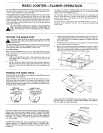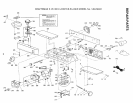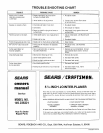
BASIC JOINTER--PLANER OPERATION
For your safety do not exceed a 1t16" deep cut on a planing operation
for work pieces wider than 1-112'". For work pieces less than 1.1/2",
a 118" cut can be taken at a slow feed rate.
This Jointer-Planer is designed with a special cutter head and inter-
nal baffle that blows the sawdust and chips from the rear of the
machine. To keep this system operating properly, the motor speed
should be maintained. A feed rate that is too fast will slow the motor
down resulting in a poor cut and poor chip discharge. The type of
wood, wood grain, and moisture content of the wood all affect an
acceptable feed rate.
CAUTION: MAKE SURE ALL SIX BLADE LOCKING SCREWS
ARE TIGHTENED SECURELY BEFORE ATTEMPTING TO
TURN THE MACHINE "ON" OR ATTEMPTING ANY OPERA-
TION.
For your own safety, ALWAYS use hold downlpush blocks when
JOINTING wood that is NARROWER than 3 in. or when PLANING
WOOD THAT IS THINNER than 3 in.
Do not plane, joint or bevel wood shorter than 12 in. Material this
short is more difficult to control while being cut. Small pieces of
wood can tip over on the tables or into the cutterhead and can be
kicked back toward you,
For best results, take light cuts. For average planing, jointing, or
beveling, a cut between 1/32 and 1/16 in. deep wil! produce the
best results.
SETTING THE GUARD STOP
,_ CAUTION: MAKE SURE THE SWITCH IS IN THE OFF POSI-
TION AND THE CORD UNPLUGGED BEFORE SETTING THE
GUARD STOP.
The guard stop assembly allows you to limit the cutter guard open-
ing during operation and can be adjusted to prevent the cutter guard
from opening when the JointerlPtaner is not in use.
As a Safety Cover
When the JolntedPlaner is not in use, rotate the guard stop and
knob clockwise until it contacts the cutter guard and lock the knob.
During Operation
1. With the JointerlPlaner switch in the off position and the cord
unplugged place a workpiece of the size to be used on the
infeed table.
2. Loosen the guard stop knob and pass the workpiece between
the fence and the cutter guard and through the cutter area
until the cutter guard is rotated as far as this workpiece will
require.
4.
5,
Rotate the guard stop and knob clockwise until it contacts the
cutter guard and lock the knob. To prevent binding or pinching,
some clearance will be required between the guard stop and
the cutter guard.
The guard stop is now set to cut workpiece of the same width
as the sample used in the set up.
Be sure to use this procedure whenever using the Jointer!
Planer and lock the cutter guard In the fully closed position
when not in use to prevent injury to anyone unfamiliar with this
tool. Failure to do so may result in serious injury.
FEEDING THE WORK PIECE
Hold the board firmly DOWN on both tables and AGAINST the fence
...keep fingers close together.
Feed the board at a continuous even rate of speed until the cut is
made along the entire length of the board. Any hesitation or stop-
ping could cause a "step" to be cut on the edge of the board which
would cause the board to ride up on the outfeed table resulting in a
"crooked" edge on the board.
t,_j t, j
ROTA_ ROTATION
Always feed WITH THE GRAIN whenever possible, if the nature of
the work piece is such that it must be fed AGAINST THE GRAIN,
take very light cuts and feed slowly.
Start with the left hand in the forward position. As the RIGHT hand
passes over the cutterhead, remove the LEFT hand...CONTINUE
feeding while placing the LEFT hand behind the RIGHT. Continue
feeding in this manner "hand over hand," until the entire length of
the board is cut. Pressure should be applied over the cutterhead
and outfeed table.
DO NOT FEED TOO FAST. A slow steady rate of feed produces a
smooth accurate cut. Feeding too fast causes a "rippled" cut...
makes it difficult to guide the workpiece accurately and could be
hazardous.
10


















